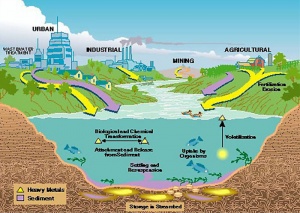Abnormal Development - Air Pollution
| Embryology - 10 May 2024 |
|---|
| Google Translate - select your language from the list shown below (this will open a new external page) |
|
العربية | català | 中文 | 中國傳統的 | français | Deutsche | עִברִית | हिंदी | bahasa Indonesia | italiano | 日本語 | 한국어 | မြန်မာ | Pilipino | Polskie | português | ਪੰਜਾਬੀ ਦੇ | Română | русский | Español | Swahili | Svensk | ไทย | Türkçe | اردو | ייִדיש | Tiếng Việt These external translations are automated and may not be accurate. (More? About Translations) |
Introduction
Draft Page - Notice removed when completed.
Air pollution has recently been identified through statistical studies to be involved with abnormal development (See also smoking). With industrialisation and vehicle produced air pollution, it can consist of particulate matter, heavy metals and a range of chemicals.
In addition to their direct toxic effects, the potential reduction in fetal growth and long-term effects should also be considered. Much of the basic research relies on studies in various animal models of development and we should also consider the ongoing development of new industrial products in the environment with unknown or untested effects upon development.
Some Recent Findings
| More recent papers |
|---|
|
This table allows an automated computer search of the external PubMed database using the listed "Search term" text link.
More? References | Discussion Page | Journal Searches | 2019 References | 2020 References Search term: Air Pollution Teratology |
| Older Papers |
|---|
| These papers originally appeared in the Some Recent Findings table, but as that list grew in length have now been shuffled down to this collapsible table.
See also the Discussion Page for other references listed by year and References on this current page.
|
References
Reviews
Articles
Search Pubmed
External Links
External Links Notice - The dynamic nature of the internet may mean that some of these listed links may no longer function. If the link no longer works search the web with the link text or name. Links to any external commercial sites are provided for information purposes only and should never be considered an endorsement. UNSW Embryology is provided as an educational resource with no clinical information or commercial affiliation.
- Globally Harmonized System of Classification and Labeling of Chemicals (GHS) | Implementation | U.S. Department of Labor
- Center for Disease Control and Prevention Screening Young Children for Lead Poisoning: Guidance for State and Local Public Health Officials | CDC - Blood Lead Levels United States, 1999-2002 | CDC - Childhood Lead Poisoning Publications
- Global Alliance to Eliminate Lead Paint
- UK Information Sheet - Cadmium and you Working with cadmium - Are you at risk?
Glossary Links
- Glossary: A | B | C | D | E | F | G | H | I | J | K | L | M | N | O | P | Q | R | S | T | U | V | W | X | Y | Z | Numbers | Symbols | Term Link
Cite this page: Hill, M.A. (2024, May 10) Embryology Abnormal Development - Air Pollution. Retrieved from https://embryology.med.unsw.edu.au/embryology/index.php/Abnormal_Development_-_Air_Pollution
- © Dr Mark Hill 2024, UNSW Embryology ISBN: 978 0 7334 2609 4 - UNSW CRICOS Provider Code No. 00098G

